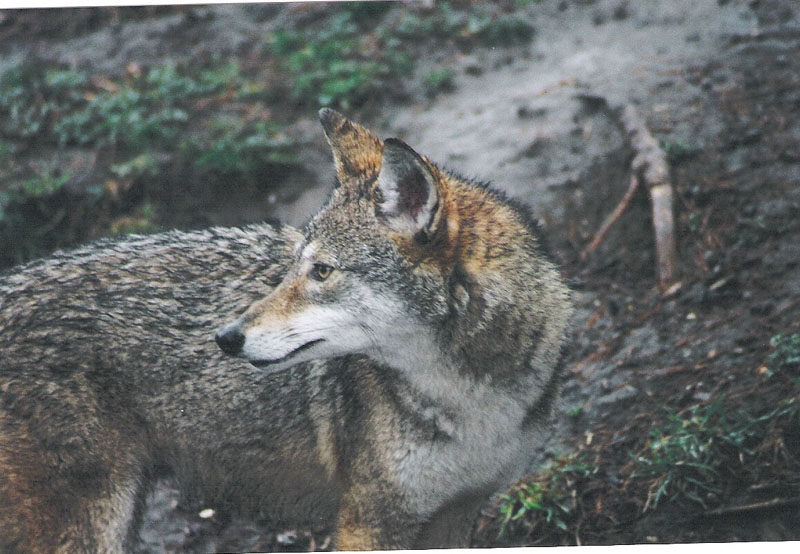Coyotes are a breed on the move

“Don’t feed the coyotes.”
That was the most pressing message that Frank Vincenti, president of The Wild Dog Foundation, brought to a meeting on the coyote presence in the Roslyn area held last Wednesday at the Shelter Rock Library.
Overall, the message was less urgent, mainly that residents shouldn’t panic when they see one. Coyotes may look ferocious, but in fact, these critters are afraid of us harmless humans. Coyotes, as with other mammals, are predators. They will congregate where there are other species and the resulting gaming opportunities. And if well-intentioned humans want to feed them, then they will be attracted to such acts of kindness. In all, however, when they see humans, including those just walking the dog, they will run and hide.
As noted in previous issues of The Roslyn News, there have been coyote sightings in Roslyn. Vincenti said that in recent years, a small coyote colony has come into being in the Bronx, a borough that is home to cemeteries and parks, including Van Cortland Park.
Coyotes are restless creatures who love to travel by night, especially during these pleasant summer evenings. And so, they travel, in small numbers and sometimes alone to Manhattan, Queens, Brooklyn and now, Long Island. Manhattan is probably not where these harmless (to humans) creatures want to go. As Vincenti explained, whenever a coyote ventures into Central Park, the New York City police department is out in full force, equipped with helicopters, tanks and cameras, all bearing down on the unsuspecting critter.
Coyotes are restless, but they are also very smart. They make the trek to Long Island by either following the railroad tracks or the Northern State Parkway. Coyotes are always on the lookout for more green space. And Nassau County provides plenty of that with its numerous parks, both large and small. Coyotes also move very quickly. In the course of their late-night travelings, these adventuresome critters can cover a 5- to 7-mile radius.
Coyotes are not going to camp out on anyone’s front lawn, nor are they going to wander onto the front porch. They look for green space and eating opportunities and then move onto the next stop. Humans find the New York City area plenty interesting and so do their coyote neighbors. As the evening draws to a close, coyotes will scamper back to their Bronx bailiwick, even though a few of them, Vincenti said, have found a home among the parks and cemeteries of Long Island, although none in the Roslyn area. Once daylight comes, coyotes find the hot weather uncomfortable and so, they hunker until the nighttime.
“Coyotes don’t hang out,” Vincenti said. If they do, he urged residents to give him a call, reiterating that the way to prevent a coyote presence is simply not to feed them.
Coyotes are adventuresome, but their existence, as with all mammals, is brief and precarious. It takes real smarts for an animal to navigate the highways and railroads tracks of the Bronx, Queens, Brooklyn and Long Island on a regular basis. But such travels take a toll. When a coyote is missing for some time, it probably means that they have been struck by a motorist. The deer hunting season in New York, Vincenti added, goes well into January. Again, it becomes inevitable that some coyotes are mistaken for foxes and deer by hunters and this, too, is how they meet their end. Plus, there is the lifespan of mammals. One coyote, dubbed “Frank” by Wild Dog Foundation members, had been living in South Jamaica, Queens, for several years. Vincenti estimated that Frank is now 12 years old, ancient for an animal. If Frank is still alive, then he is elderly and even that much more harmless.
In the meantime, coyotes will mate in January and give birth in March. Vincenti lauded Long Islanders for their excellent behavior in dealing with their occasional new neighbors. Coyotes will prey on squirrels, birds—and most alarming for Roslyn residents—geese.
They will scrap with cats and dogs if it comes to that. Vincenti added that residents should keep their feline pets indoors and when they walk the dog, do so with a 4- to 6-foot leash, not an elastic leash that stretches out to ridiculous lengths. If coyotes spot a dog, there might, as noted, be a confrontation. But if that dog is on a leash, the coyote, seeing a human, will back off. Still, Vincenti urged dog owners to be “aggressive” with any coyote, even to the point of yelling at them, chasing them off and throwing objects.
Coyotes, when they discover those pleasant Roslyn events, will exist peacefully among us before moving on.































